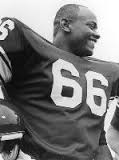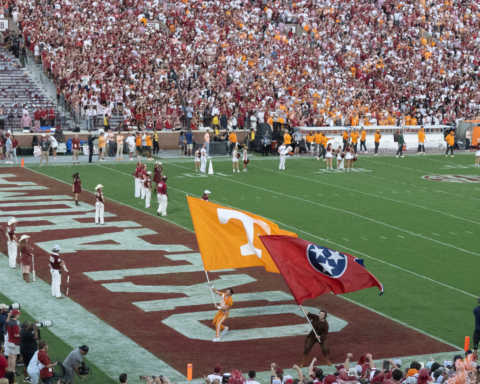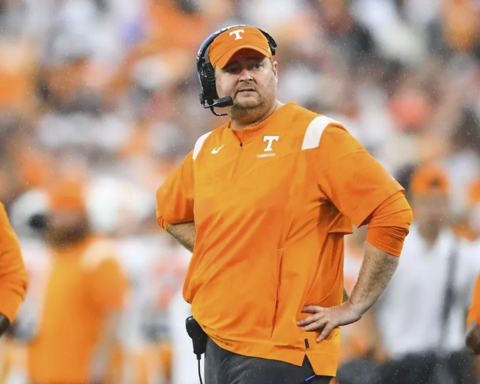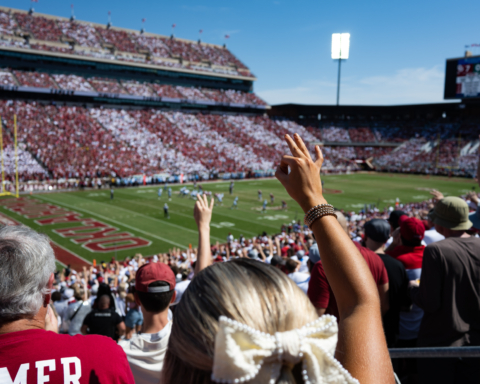 The first televised Oklahoma football game I ever paid attention to was the last time the Sooners played Tennessee.
The first televised Oklahoma football game I ever paid attention to was the last time the Sooners played Tennessee.
It was January 1, 1968, when Oklahoma played No. 2 Tennessee in the Orange Bowl.
That game marked the conclusion of a Cinderella 1967 season for the Sooners. It also was my first “official” season as a rabid Sooner football fan.
The game which allowed Oklahoma to play Tennessee was the Big 8 clash with the Kansas Jayhawks in Norman on November 18, 1967. It was the first OU football game I remember attending in person. A cold front had come through days before that was so chilling that I gave up at halftime of our Velma-Alma high school playoff game the night before for the warm confines of home.
On campus the next day in Norman it was crispy cold. I was sitting there in Section 17 of the north end zone with family. It had gotten even colder after the Jayhawks built up a 10-0 lead that jeopardized the Sooners’ hopes of making it to Miami for New Year’s.
I was firmly convinced that my great uncle Ralph, who had traveled all the way from his home in Kansas City, Kansas to join us for the Sooners-Jayhawks clash, was a Jayhawker who had jinxed my Sooners. I was suspicious of anyone, family or not, living in Kansas then. I was certainly suspicious of Ralph, who, in his Jerry Clower-like manner, cajoled me into thinking KU was going to put it on my poor pitful Sooner boys. (But, I learned many years later that Ralph was indeed a diehard crimson and cream Sooner who feigned KU loyalty just to get this then 9-year-old all riled up.)
Fortunately, thanks to OU greats QB Bobby Warmack and TE Steve Zabel, Oklahoma came back to win that game on a 30-yard pass and catch for a game-winning touchdown with but a minute left in the game.
Florida oranges came raining out of the stands, covering the grass Owen Field with splotches of orange — a visual fanfare every bit as magnificent as a blaring chorus of regal trumpets — announcing the Sooners were on their way to the Orange Bowl to play Tennessee.
Florida oranges came raining out of the stands, covering the grass Owen Field with splotches of orange — a visual fanfare every bit as magnificent as a blaring chorus of regal trumpets — announcing the Sooners were on their way to the Orange Bowl to play Tennessee.
Florida oranges came raining out of the stands, covering the grass Owen Field with splotches of orange — a visual fanfare every bit as magnificent as a blaring chorus of regal trumpets — announcing the Sooners were on their way to the Orange Bowl to play Tennessee.
I didn’t realize then those cascading oranges also announced the return of Oklahoma to national prominence not seen since some guy named Bud Wilkinson coached in Norman. The Sooners had not won 10 games or been ranked since 1958 — the year I was born.
It was an important day. The cloth red and white University of Oklahoma pennant my parents bought me that Saturday hangs in my house to this very day.
After being bitten with the Sooner bug in November, it was a given that I was going to watch my team play in the Orange Bowl on New Year’s Day on NBC against the No. 2 Tennessee Volunteers.

A nationally televised college football game was unusual back then. There was ordinarily only one college football game on the tube each Saturday. Seeing Warmack and Zabel on television — the same guys I saw in person on the field in Norman — was a big deal. To see them all the way from Miami, Florida and into our living room was a really big deal.
But the Sooner I remember most on our black and white TV that first holiday of ’68 was No. 66 Granville Liggins. Before there were the Selmon brothers, before there was Tony Casillas and before anyone knew of Brian Bosworth, there was Granville Liggins. He was a consensus All-American noseguard at OU and star wrestler too.
He was also the first black athlete, that I, at age 9, emulated.
As a little white boy in an all-white small town in Oklahoma I was oblivious to any racial tension of the 1960s and equally oblivious that the color of Liggins’ skin would matter to anybody. It certainly didn’t to me. I wanted to be Granville Liggins. I was just amazed at how fast he was. How he dominated offensive lines. And, he was one of us. (Liggins went on to become a 10-year star of the Canadian Football League).
On this New Year’s night in the Orange Bowl Liggins was winning the battle against All-American Tennessee center Bob Johnson. Tennessee was forced to double team Liggins to keep him away from the Vol quarterback. Thanks to this strong defense, the Sooners shut the Vols out in the first half, leading 19-0 at halftime.
But, when Liggins got injured in the second half, his absence gave Tennessee momentum. The Sooners were clinging to a 26-24 lead when first-year OU Head Coach Chuck Fairbanks gambled to put the game away by foregoing a punt and attempting a fourth down conversion from the OU 43. This was scary, I remember. Sophomore Steve Owens — an emerging star at running back — was stuffed for no gain with 1:54 left in the game and the Sooners turned the ball over on downs. This did not look good for us.
The Vols advanced to the OU 27 and set up for a game-winning field goal attempt. In an occurrence that in later years would be dubbed something called “Sooner Magic”, Tennessee kicker Karl Kremser’s attempt went awry.
Oklahoma won the Orange Bowl 26-24 and finished the season No. 2 in the country. And, on that night, through the power of television and the misfortunes of Tennessee, I was thoroughly and forever Sooner born and Sooner bred.
Forty seven years later the Tennessee Volunteers and the Oklahoma Sooners go at it again. I hope this time is not nearly as exciting.
But I am sure, if the Sooners prevail, there is somewhere in the north endzone or at home watching on TV a 9-year-old who will some day say that it was this win over Tennessee that began it all for them.

 Follow
Follow


